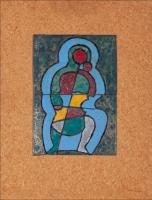Iris Francis was born in Fremantle, Western Australia, in 1913, into a
family deeply interested in the arts. Her grandfather and father were both
talented in sketching and carving, and her aunt, Pansy Francis, was a
renowned woodcarver. Growing up in such a creative environment, from a
young age Iris was naturally drawn to the arts.
...
She pursued formal training at Perth Technical College, studying under JWR
Linton and AB Webb, where she earned a diploma in commercial art. After
completing her studies, Iris began working as a commercial artist at
Gibbney & Sons before being offered a permanent teaching position at
Perth Technical College in 1935. She would go on to teach there for twelve
years.
In addition to her artistic talents, Iris was an accomplished cellist. She
performed at numerous fundraising recitals during the war, using her music
to support important causes. Her versatility extended beyond the visual and
performing arts, as she was also a skilled golfer, having won the
Vice-President’s Cup at the Royal Fremantle Golf Club in 1937 with a net
score of 70, reducing her handicap by five strokes.
Her involvement in the arts extended beyond her teaching and personal
practice. Iris was an active member of both the Perth Society of Artists
and the Women Painters and Applied Arts Society, contributing to the growth
of the arts community in Western Australia.
This enamel work“The Cellist”, reflects her deep interest in
modernism, which flourished during WWII. The work is not only a tribute to
her accomplishments as a cellist but also an embodiment of the modernist
movement she embraced. Created likely in the 1950s, “The Cellist”
was made possible by the availability of additional materials during the
post-war period.
A larger oil painting of the same title and design is included in the
collection of the Art Gallery of Western Australia ensuring her legacy and
contribution to the arts is preserved.
Read more


